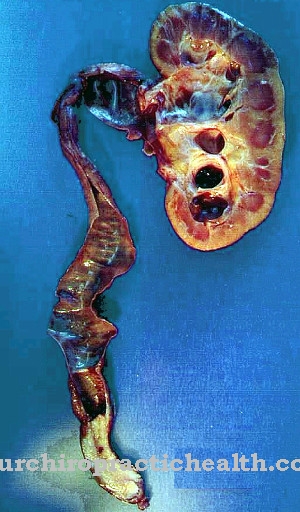What is Thoracic Outlet Syndrome?

© contrastwerkstatt - stock.adobe.com
The neurovascular syndromes are a group of diseases that show neurological symptoms and pathological blood flow processes at the same time. Most of these syndromes are among the compression disorders and are due to the jamming of the nerve-vascular plexuses, as occurs in every human body. This is a clinical picture from this group Thoracic outlet syndrome.
This subgroup of neurovascular syndromes includes several phenomena that lead to compressions of the nerve-vascular plexus composed of the brachial plexus, subclavian artery and subclavian vein. The most important symptoms of the group are hyperabduction syndrome, pectoralis minor syndrome, Paget-von-Schroetter syndrome and costoclavicular syndrome.
In the thoracic outlet syndrome, the vascular nerve bundle can be temporarily or permanently compressed. The beach stretches along the neck towards the extremities and has to overcome various bottlenecks on its way. In particular, the anterior and posterior gaps in the scalene, the costoclavicular space between the rib and clavicle and the coracopectoral space between the coracoid process and the pectoralis muscle. The line can get jammed at any of these bottlenecks. The symptoms depend on the location of the compression.
causes
The vascular nerve cord of the arm can become jammed at three narrow points. The compression of the structures at these points is the primary cause of thoracic outlet syndrome. The jamming in the gaps in the scalenus corresponds to the scalene syndrome. This sub-form of the syndrome is favored by existing cervical ribs, by exostoses or the steep position of the upper ribs, as well as by hypertrophy of the scalene muscles.
With the latter cause, the syndrome is known as anterior scalene syndrome. Thoracic outlet syndrome due to a rib cervical is called cervical rib syndrome. If there is a blockage in the costoclavicular space, the thoracic outlet syndrome is present in the form of a costoclavicular syndrome. This phenomenon occurs mainly after clavicle fractures, which can cause excessive callus formation.
In addition, compression in this area can occur with maximum abduction of the arm. If the cause of the thoracic outlet syndrome is jamming of the neurovascular bundle in the area of the coracopectoral space, either hyperabduction syndrome or pectoralis minor syndrome is present. The symptoms are mostly due to hypertrophy of the pectoralis minor muscle.
The thoracic outlet syndrome is also partly associated with causative Pancoast tumors. If the vascular nerve bundle is jammed in constrictions in the subclavian vein, a special form of thoracic outlet syndrome is present.
Symptoms, ailments & signs
The clinical symptoms of thoracic outlet syndrome vary with the location of the blockage. Because the vessels are pinched, blood flow is impeded. These circulatory disorders can make themselves felt, for example, when the arm becomes heavy and cold. The extremity falls asleep, loses color or turns red in certain places.
The special form of the thoracic outlet syndrome can also cause venous outflow disorders and thus cause thromboses, such as the Paget-von-Schroetter syndrome. The neurological symptoms of the syndrome start with mild sensory disturbances and end with symptoms of paralysis of the entire arm. Both the sensory and motor nerves of the arm can be jammed in the described bottlenecks.
If only sensitive nerves are affected by compression, numbness sets in. Other sensory disorders such as a disturbed feeling of hot and cold or an abnormal feeling of pain may also occur. If motor nerves are affected in addition to the sensory nerves, this usually manifests itself in movement disorders.
The muscles contract weakly and muscle tremors can occur. The deep sensitivity can be disturbed, which leads to a reduced coordination of movements and strength. Remitting symptoms and thus temporary deadlocks exist when the symptoms recede as soon as the patient changes their posture.
Diagnosis & course of disease
A suspected diagnosis of thoracic outlet syndrome can be made based on the anamnesis. The doctor can then trigger the symptoms in a provocation test and thus confirm the suspected diagnosis. The most important tests in this context are the final fist test and the Adson test. Diagnosis also includes chest x-rays and cervical spine.
The imaging can be used to find the exact cause of the deadlock and the appearance can be assigned to a sub-shape. The doctor uses electroneurography to detect damage to the nerve lines in the affected area. To confirm the diagnosis, the vascular blood flow is shown in different positions of the arm as part of a duplex sonography. Patients with thoracic outlet syndrome generally have an excellent diagnosis. Complications such as thrombosis are more of a special case.
Complications
First and foremost, those affected by thoracic outlet syndrome suffer from severe disturbances in blood flow. This can lead to disorders of sensitivity or paralysis, which make everyday life much more difficult for the person concerned. Especially the extremities are affected by the disorders, so that they tingle or fall asleep. Furthermore, the skin color can also change.
In most cases the paralysis due to thoracic outlet syndrome is only temporary. The perception of temperature may also be disturbed, so that the person concerned is more likely to injure himself or not be able to correctly assess the dangers. Furthermore, without treatment, movement disorders and muscle tremors occur. If the thoracic outlet syndrome is not treated, the paralysis can in the worst case be permanent.
As a rule, the symptoms of thoracic outlet syndrome can be relieved relatively easily by repositioning the body or the affected body region. However, in some cases, surgical interventions and various therapies are necessary to limit the symptoms. As a rule, complications do not arise. In most cases, life expectancy is neither restricted nor reduced.
When should you go to the doctor?
Thoracic outlet syndrome should always be treated by a doctor. No self-healing can occur here, so that the person concerned is always dependent on a medical examination with subsequent treatment. This is the only way to prevent further complications. In the case of thoracic outlet syndrome, the doctor should be consulted if the person concerned suffers from circulatory disorders. These disorders can occur in different parts of the body and have a very negative effect on the quality of life of the person concerned. Furthermore, severe signs of paralysis can also indicate the thoracic outlet syndrome. Those affected suffer from movement disorders and muscle complaints.
This leads to tremors and severe pain in the muscles, which can also occur without strain. If these symptoms occur, the thoracic outlet syndrome must definitely be examined by a doctor. The thoracic outlet syndrome can be recognized by a general practitioner. The further treatment then depends on the exact type and severity of the symptoms and is carried out by a specialist.
Treatment & Therapy
Thoracic outlet syndrome does not require further treatment in all cases. If the symptoms are only temporary and also subtle, therapy does not have to take place.If the patient nevertheless wants to prevent the occurrence, he receives tips on preventive positioning of the arms and body. If the symptoms are more pronounced, either conservative or surgical therapy is used.
Intervention in the case of permanent compressions is particularly important, since such phenomena, in addition to tissue ischemia, can result in the death of nerve cells. The conservative therapy approach is usually only suitable for less pronounced manifestations of the disease and consists primarily of physiotherapeutic steps.
In addition to manual grips, active exercises to strengthen the shoulder girdle and massages in the region, the conservative therapy path includes the use of heat, which causes the muscles to relax. In the case of a pronounced thoracic outlet syndrome, the surgical measures correspond to an invasive removal of the causal bottleneck. This removal can correspond to the removal of a neck rib, for example. The operation is followed by physiotherapy.
prevention
Various forms of thoracic outlet syndrome can be prevented through posture training and relaxation techniques, which loosen up the muscles and thus reduce any constrictions.
Aftercare
The follow-up treatment of thoracic outlet syndrome depends on the type of treatment and on the secondary diseases that have arisen as a result of the thoracic outlet syndrome. The surgical treatment of thoracic outlet syndrome should always be followed by intensive rehabilitation physiotherapy. The focus is on the remobilization of the shoulder and the restoration of normal functionality of the shoulder and shoulder girdle muscles.
Accordingly, physiotherapy should consist of heat treatments, massage applications and exercises to strengthen the muscles. If the thoracic outlet syndrome has been completely cured, no further follow-up treatment is required. If chronic pain persists even after treatment of the thoracic outlet syndrome, additional pain therapy can be considered.
In addition to the administration of painkillers, this also includes physiotherapeutic measures that should reduce the pain in the muscles, arm and shoulder by increasing mobility. Primarily, however, if the pain persists after the treatment of thoracic outlet syndrome, pain relief must be medicated.
If necessary, the use of opioids (tilidine) comes into consideration here. In this case, the liver and kidney function values must also be checked regularly in the blood so that a reduction in organ activity resulting from the therapy with the opioids can be determined at an early stage and countermeasures can be taken. In addition, alcohol consumption must be avoided for life in this case, as it can additionally damage the liver and kidneys.
You can do that yourself
The therapy of thoracic outlet syndrome can be supported by a number of measures. Physiotherapy treatment is accompanied by appropriate gymnastics. The sports doctor or physiotherapist can suggest suitable exercises to strengthen the shoulder girdle muscles. The sporting activity may be gradually extended, provided that the thoracic outlet syndrome heals as desired.
The use of massages is used to loosen up the muscles. Patients can massage themselves or get professional massage to relieve the discomfort. In addition, the application of heat counteracts hardening. The doctor must monitor the self-help measures.
Surgical intervention is necessary if the symptoms are severe. After the constriction has been surgically removed, physiotherapeutic measures are also indicated. The typical general measures such as protection and monitoring of the surgical wound also apply. If any inflammation, bleeding or pain is noticed, the doctor should be consulted.
Finally, in the case of thoracic outlet syndrome, possible amplifiers must be eliminated. Misalignments often develop, which in the long term can lead to joint wear and other complications. These physical problems must be corrected as part of physiotherapy. The patient can, in turn, support the physiotherapy through targeted training of the affected regions at home.

























.jpg)

.jpg)
